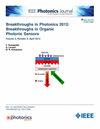Non-Invasive Glucose Sensing on Fingertip Using a Mueller Matrix Polarimetry With Machine Learning
IF 2.4
4区 工程技术
Q3 ENGINEERING, ELECTRICAL & ELECTRONIC
引用次数: 0
Abstract
This study achieved significant predictive results using Mueller Matrix Polarimetry combined with the XGBoost algorithm for non-invasive glucose sensing of biological tissues on human fingertips. The experiment used a 660nm laser in polarimetry and incident angle optimization to enhance measurement capabilities, comprehensively obtaining properties including Linear Birefringence (LB), Circular Birefringence (CB), linear dichroism (LD), Circular Dichroism (CD), and Degree of Polarization (DoP). Phantom models simulated the interference properties of biological tissue polarization measurements. The XGBoost regression model, with feature engineering based on correlation matrices, showed consistent trends in both phantom and human measurements. As a result, the prediction results for glucose concentration in phantom mixtures were R² = 0.96 and Mean Absolute Relative Difference (MARD) = 8.67%. Furthermore, the prediction of glucose concentration on human fingertips achieved R² of 0.89, and MARD of 2.92% using the features:基于机器学习的穆勒矩阵偏振法在指尖上的无创葡萄糖传感
本研究采用Mueller Matrix偏振法结合XGBoost算法对人体指尖生物组织进行无创葡萄糖传感,取得了显著的预测结果。实验采用660nm激光进行偏振和入射角优化,提高测量能力,综合获得线性双折射(LB)、圆双折射(CB)、线性二色性(LD)、圆二色性(CD)和偏振度(DoP)等特性。幻影模型模拟了生物组织偏振测量的干涉特性。基于相关矩阵的特征工程的XGBoost回归模型显示了幻影和人体测量的一致趋势。结果表明,幻影混合物中葡萄糖浓度的预测结果为R²= 0.96,平均绝对相对差(MARD) = 8.67%。此外,葡萄糖浓度的预测人类指尖达到0.89 R²,和MARD 2.92%的使用特点:$ {{R} _1} $, $ {{m} _ {32}} $, $ S{{1} ^{{{{45}} ^ \保监会}}}$,$ S{{2} ^{{{{45}} ^ \保监会}}}$,$ S {{1} ^ R} $, $痛单位{{P} ^ R} $,和${{年代}_ {tol}} $。研究发现,对于使用机器学习预测人体血糖,CB、CD、DoP和总光强是至关重要的光学性质。
本文章由计算机程序翻译,如有差异,请以英文原文为准。
求助全文
约1分钟内获得全文
求助全文
来源期刊

IEEE Photonics Journal
ENGINEERING, ELECTRICAL & ELECTRONIC-OPTICS
CiteScore
4.50
自引率
8.30%
发文量
489
审稿时长
1.4 months
期刊介绍:
Breakthroughs in the generation of light and in its control and utilization have given rise to the field of Photonics, a rapidly expanding area of science and technology with major technological and economic impact. Photonics integrates quantum electronics and optics to accelerate progress in the generation of novel photon sources and in their utilization in emerging applications at the micro and nano scales spanning from the far-infrared/THz to the x-ray region of the electromagnetic spectrum. IEEE Photonics Journal is an online-only journal dedicated to the rapid disclosure of top-quality peer-reviewed research at the forefront of all areas of photonics. Contributions addressing issues ranging from fundamental understanding to emerging technologies and applications are within the scope of the Journal. The Journal includes topics in: Photon sources from far infrared to X-rays, Photonics materials and engineered photonic structures, Integrated optics and optoelectronic, Ultrafast, attosecond, high field and short wavelength photonics, Biophotonics, including DNA photonics, Nanophotonics, Magnetophotonics, Fundamentals of light propagation and interaction; nonlinear effects, Optical data storage, Fiber optics and optical communications devices, systems, and technologies, Micro Opto Electro Mechanical Systems (MOEMS), Microwave photonics, Optical Sensors.
 求助内容:
求助内容: 应助结果提醒方式:
应助结果提醒方式:


